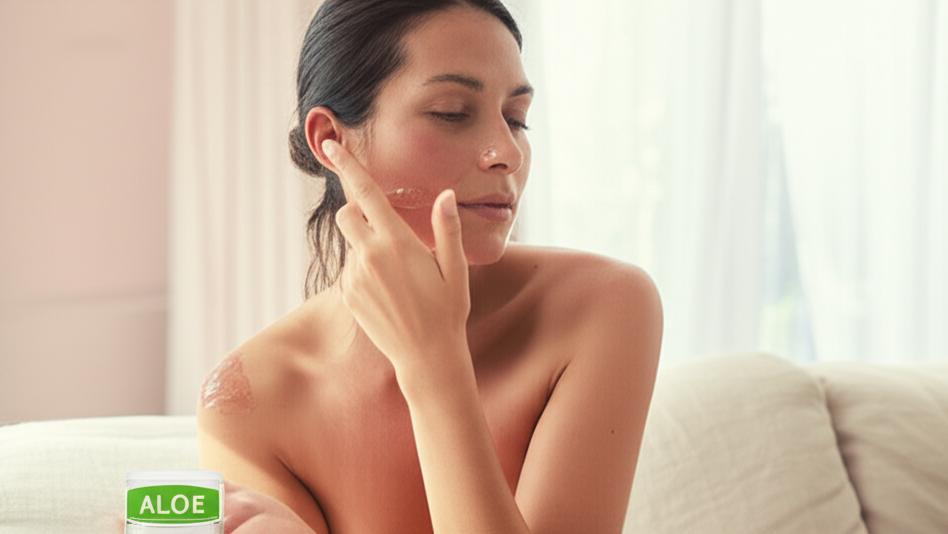It’s one of those perfect summer afternoons. You’re out enjoying the sunshine, maybe a bit longer than you planned. Later that evening, as you’re getting ready for bed, you catch a glimpse of yourself in the mirror – oh dear. Your skin is glowing a painful-looking red, and it’s tender to the touch. Yep, that’s a sunburn making its unwelcome appearance. We’ve all been there, haven’t we?
So, what exactly is a sunburn? Simply put, it’s your skin telling you it’s been damaged by too much ultraviolet (UV) light from the sun, or even from a tanning bed. And it doesn’t just happen on beach holidays. I’ve seen patients get sunburns from just sitting out during a lunch break, gardening, or even walking the dog without proper protection. Repeated sunburns, unfortunately, can lead to your skin aging faster than it should and increase your risk for skin cancer.
Understanding Sunburn: What’s Happening to Your Skin?
When we talk about sunburn, we’re generally looking at a couple of types, depending on how deep the damage goes:
- First-degree sunburn: This is the most common type. It affects the outermost layer of your skin, what we call the epidermis. It’s red, sore, and might feel warm. Usually, this kind of burn settles down on its own in a few days to a week.
- Second-degree sunburn: This one goes a bit deeper, into the middle layer of your skin, the dermis. You’ll likely see blisters forming, and it’s generally more painful. Healing can take a few weeks, and sometimes it’s best to get it checked out.
There’s also something called a third-degree sunburn, but thankfully, it’s incredibly rare from sun exposure alone. These are severe burns that damage all skin layers and usually happen from things like chemical burns or fire. These always need emergency medical care.
Sunburns are super common. It’s estimated that a huge chunk of kids under 18 get one each year, and plenty of adults do too. It’s a reminder that the sun’s rays are powerful!
What Does a Sunburn Look and Feel Like?
If you’ve got a sunburn, your skin often feels like it’s literally on fire – hot, burning, and any touch, even from clothes, can be agony.
Here’s what you might notice:
For a First-Degree Sunburn:
- Redness: This is classic. On darker skin, it might be a bit harder to spot the redness, but you might notice peeling or tenderness later.
- Skin that feels hot or tight.
- Pain or tenderness when touched.
- Some swelling.
- Peeling skin a few days later, as your body gets rid of the damaged cells.
Sometimes, you might also feel a bit off in general, with:
- Fatigue (feeling tired)
- A mild fever
- Headache
- Even a bit of nausea.
For a Second-Degree Sunburn (this is what many call a “bad sunburn”):
- The skin will be intensely red.
- Blisters will likely form – these are little bubbles of fluid.
- More noticeable swelling, often over a larger area.
- The skin might look a bit wet or weepy.
- It’s usually quite painful.
- You might see some white discoloration within the burned area.
With a more severe burn, you could also experience symptoms of heat illness, like:
- Feeling confused
- Dizziness
- Exhaustion
- Fast breathing
- Fever
- A throbbing headache
- Muscle cramps
- Nausea
- Even shivers, despite feeling hot.
The Sunburn Timeline – What to Expect
You probably won’t feel the sunburn right away while you’re in the sun. The ouch usually kicks in a few hours later.
- The pain often starts within a few hours.
- The redness and irritation tend to get worse, with pain usually peaking around 24 hours after the burn. If it’s a second-degree burn, this is when blisters often show up.
- Over the next week or so, the damaged skin will likely peel, and your skin should gradually go back to its normal color. For more severe burns, this healing process can take a bit longer.
What’s Causing That Burn?
The culprit behind sunburn is ultraviolet (UV) radiation from the sun. There are two main types we worry about: UVA and UVB. Both can burn your skin.
Anyone can get a sunburn, but some things make it more likely:
- How long you’re in the sun: Obvious, I know, but crucial!
- Certain medications: Some drugs, like certain antibiotics (e.g., doxycycline, Bactrim™), NSAIDs (non-steroidal anti-inflammatory drugs), retinoids, and some heart medications like diuretics, can make your skin much more sensitive to the sun.
- UV intensity: This changes depending on the time of day (strongest mid-day), cloud cover (you can still burn on cloudy days!), altitude (stronger at high altitudes), and how close you are to the equator.
- Skin type and color: Fairer skin tends to burn more easily, but everyone can burn.
- Tanning beds: These are a big no-no from my perspective; they blast your skin with UV rays.
How Do We Figure Out How Bad It Is?
Usually, you know if you have a sunburn. If you come to see me or another healthcare provider, we’ll look at how much of your skin is affected, how red or blistered it is, and ask about your symptoms. This helps us recommend the best way to help you feel better.
Soothing Your Sunburn: What Can You Do?
Most first- and second-degree sunburns can be managed at home. Here’s what I usually tell my patients:
- Cover up: Keep the burned skin covered when you go outside while it’s healing. Cool, damp cloths can feel really good on the skin.
- Cool and hydrate the skin: Gentle, cooling gels and creams can be a lifesaver. Think aloe vera gel or a mild hydrocortisone cream (0.5% or 1% available over the counter).
- Moisturize (after initial cooling): Once the heat is out of the skin, applying an unscented moisturizer, petroleum jelly, or even an antibiotic ointment (if blisters have popped on their own) can help keep the skin hydrated and promote healing.
- Drink plenty of water: Your body loses fluids when you’re burned, so staying hydrated is important.
- Cool baths or showers: Lukewarm or cool water is best. Adding some oatmeal or baking soda to a bath can be very soothing.
- Pain relief: Over-the-counter NSAIDs like ibuprofen can help with pain and inflammation.
- Leave blisters alone! Seriously, don’t pop them. They’re like little natural band-aids protecting the skin underneath. If they get huge or really uncomfortable, it’s best to see us. And don’t peel the skin; let it come off naturally.
For really severe blistering or if you’re showing signs of dehydration, we might need to give you fluids, sometimes through an IV. As mentioned, third-degree burns are a different story and require specialized hospital care, sometimes including skin grafts.
What’s the Outlook? How Long Will This Last?
The good news is that the immediate pain and redness from a typical sunburn usually improve within a few days to a week. More severe burns will take longer. The not-so-good news? The damage to the DNA in your skin cells is permanent. Each sunburn you get adds to your cumulative sun damage and increases your risk of skin cancer down the line.
Long-Term Effects of Sunburns
Getting sunburned often, especially if it’s severe and blistering, can lead to:
- Premature skin aging: This means more wrinkles, age spots (liver spots), freckles, visible red veins, and sagging skin sooner than you’d expect.
- Precancerous skin lesions: These are rough, scaly patches (called actinic keratoses) that can sometimes turn into skin cancer.
- Eye damage: UV exposure can contribute to cataracts.
- Skin cancer: This is the big one we worry about. It’s more common on areas that see a lot of sun, like your arms, back, ears, face, and legs. Skin cancers can look like pink scaly spots, sores that just won’t heal, or even new or changing moles.
How does a sunburn lead to skin cancer?
When UV rays hit your skin, they can damage the DNA within your skin cells. Your skin reacts by increasing blood flow to the area (hello, redness and heat!) and sending in immune cells to try and repair the damage. Some cells die off (that’s the peeling), some get repaired, but some damaged cells with faulty DNA can survive. If these cells start to multiply uncontrollably, that’s how skin cancer can develop.
Staying Safe in the Sun: Preventing Sunburn
Prevention is always, always better than cure when it comes to sunburn. Here’s how you can protect your skin:
- Sunscreen, sunscreen, sunscreen! Use a broad-spectrum sunscreen (protects against UVA and UVB) with an SPF of 30 or higher. Apply it generously every day, even on cloudy days. Reapply every 90 minutes or so when you’re outdoors, and more often if you’re swimming or sweating a lot.
- Avoid tanning beds and deliberately sun tanning. There’s no such thing as a “healthy tan” from UV rays.
- Be extra careful if you’re on medications that increase sun sensitivity. Ask your doctor or pharmacist if any of your meds do this.
- Limit sun exposure during peak hours: The sun’s rays are strongest between 10 a.m. and 4 p.m.
- Get regular skin checks: See a dermatologist for an annual skin cancer screening, especially if you have a lot of moles or a family history of skin cancer.
- Wear sunglasses: Choose ones that filter UV rays to protect your eyes.
- Hats are your friend: Especially if you’re bald or have thinning hair, a wide-brimmed hat is great.
- Protective clothing: Long-sleeved shirts and long pants made of tightly woven fabric offer good protection.
You’re at higher risk if you:
- Have fair skin, freckles, blue eyes, or red/blonde hair.
- Live or spend time at high altitudes or near the equator.
- Are often outdoors for sports or swimming.
- Spend lots of time on the water (boating, fishing).
- Work outdoors.
When to Ring Your Doctor About a Sunburn
Most sunburns don’t need a doctor’s visit, but please do reach out if you’re worried or if you notice:
- Extensive blistering: Especially if it covers more than 20% of your body (like a whole leg or your entire back).
- Severe swelling.
- Chills.
- Extreme pain that isn’t managed by over-the-counter pain relief.
- A fever over 102°F (39°C).
- Signs of dehydration: Feeling very dizzy, having a dry mouth, extreme fatigue, being very thirsty, or not peeing much.
- Signs of infection in the blisters: This could be pus, increasing redness, or warmth spreading from the blister.
- Any sunburn in a baby younger than one year old. Babies have very delicate skin and need to be seen.
Take-Home Message: Sunburn Smarts
Alright, let’s quickly recap the main points about sunburn:
- Sunburn is skin damage from UV rays, and it’s preventable.
- Symptoms range from redness and pain (first-degree) to blisters and severe pain (second-degree).
- Home care with cool compresses, aloe, moisturizers, and hydration often does the trick.
- Never pop blisters!
- Repeated sunburns increase your risk for premature aging and skin cancer.
- Daily sunscreen use (SPF 30+), protective clothing, and avoiding peak sun hours are key to prevention.
- See a doctor for severe burns, signs of infection, dehydration, or if a baby gets burned.
You’re not alone if you’ve had a sunburn, but by being a bit more sun-savvy, we can try to make them a thing of the past. Take care of your skin – it’s the only one you’ve got!


